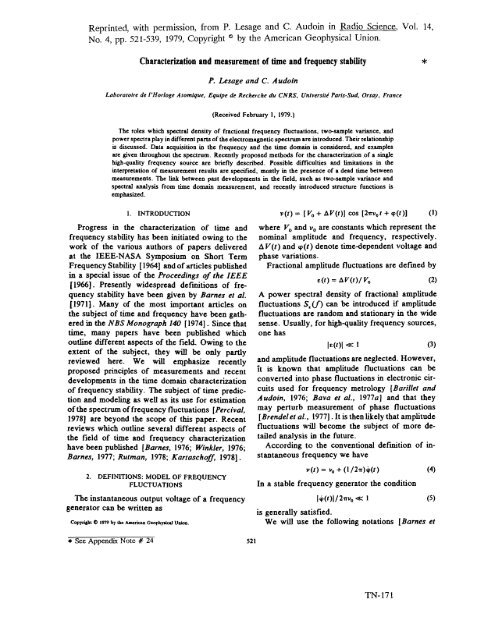NIST Technical Note 1337: Characterization of Clocks and Oscillators
NIST Technical Note 1337: Characterization of Clocks and Oscillators
NIST Technical Note 1337: Characterization of Clocks and Oscillators
Create successful ePaper yourself
Turn your PDF publications into a flip-book with our unique Google optimized e-Paper software.
Reprinted, with permission, from P. Lesage <strong>and</strong> C Audoin in Radio Science, VoL 14,No.4, pp. 521-539, 1979, Copyright © by the American Geophysical Union.<strong>Characterization</strong> <strong>and</strong> measurement <strong>of</strong> time <strong>and</strong> frequency stabilityP. Lesage <strong>and</strong> C. A udoin*Laboratoire de f'Horloge Atomique, Equipe de Recherche du CNRS, Universili Paris-Sud, Orsay, France(Received February I, 1979.)The roles which spectral density <strong>of</strong> fractional frequency fluctuations, two-sample variance, <strong>and</strong>power spectra play in different pans <strong>of</strong> the electromagnetic spectrum are introduced. Their relationshipis discussed. Data acquisition in the frequency <strong>and</strong> the time domain is considered, <strong>and</strong> examplesare given throughout the spectrum. Recently proposed methods for the characterization ,<strong>of</strong> a singlehigh-quality frequency source are briefly described. Possible difficulties <strong>and</strong> limitations in theinterpretation <strong>of</strong> measurement results are specified, mostly in the presence <strong>of</strong> a dead time betweenmeasurements. The link between past developments in the field, such as two-sample variance <strong>and</strong>spectral analysis from time domain measurement, <strong>and</strong> recently introduced structure functions isemphasized.I. INTRODUCTIONProgress in the characterization <strong>of</strong> time <strong>and</strong>frequency stability has been initiated owing to thework <strong>of</strong> the various authors <strong>of</strong> papers deliveredat the IEEE-NASA Symposium on Short TermFrequency Stability [1964] <strong>and</strong> <strong>of</strong> articles publishedin a special issue <strong>of</strong> the Proceedings <strong>of</strong> the IEEE[1966J. Presently widespread defmitions <strong>of</strong> frequencystability have been given by Barnes et al.(l97IJ. Many <strong>of</strong> the most important articles onthe subject <strong>of</strong> time <strong>and</strong> frequency have been gatheredin the NBS Monograph 140 [1974]. Since thattime, many papers have been published whichoutline different aspects <strong>of</strong> the field. Owing to theextent <strong>of</strong> the subject, they will be only partlyreviewed here. We will emphasize recentlyproposed principles <strong>of</strong> measurements <strong>and</strong> recentdevelopments in the time domain characterization<strong>of</strong> frequency stability. The subject <strong>of</strong> time prediction<strong>and</strong> modeling as well as its use for estimation<strong>of</strong>the spectrum <strong>of</strong>frequency fluctuations [Percival,1978J are beyond the scope <strong>of</strong> this paper. Recentreviews which outline several different aspects <strong>of</strong>the field <strong>of</strong> time <strong>and</strong> frequency characterizationhave been published [Barnes, 1976; Winkler, 1976;Barnes, 1977; Rutman, 1978; Kartasch<strong>of</strong>f, 1978].2. DEFINITIONS: MODEL OF FREQUENCYFLUCTUAnONSThe instantaneous output voltage <strong>of</strong> a frequencygenerator can be written asCopyriahl Cl 1979 by the Americon Geophysical UDioa.V(I) = [Vo + AV(t») cos [2'1Tvol + '9(1»where V o <strong>and</strong> V o are constants which represent thenominal amplitude <strong>and</strong> frequency, respectively.tJ. V(t) <strong>and</strong> cp(t) denote time-dependent voltage <strong>and</strong>phase variations.Fractional amplitude fluctuations are defmed by(I)E(t) = AV(t)! V o (2)A power spectral density <strong>of</strong> fractional amplitudefluctuations S.if) can be introduced if amplitudefluctuations are r<strong>and</strong>om <strong>and</strong> stationary in the widesense. Usually, for high-quality frequency sources,one hasIE(t)1 « I (3)<strong>and</strong> amplitude fluctuations are neglected. However,it is known that amplitude fluctuations can beconverted into phase fluctuations in electronic circuitsused for frequency metrology [Barillet <strong>and</strong>Audoin, 1976; Bava et al., 1977a] <strong>and</strong> that theymay perturb measurement <strong>of</strong> phase fluctuations[Brendel et al., 1977]. It is then likely that amplitudefluctuations will become the subject <strong>of</strong> more detailedanalysis in the future.According to the conventional defmition <strong>of</strong> instantaneousfrequency we haveV(I) = "0 + (l /2'1T)cP(l) (4)In a stable frequency generator the conditionIcP(t)1I2'1Tvo « I (5)is generally satisfied.We will use the following notations [Barnes et'" See Appendix <strong>Note</strong> # 24 521TN-171
















